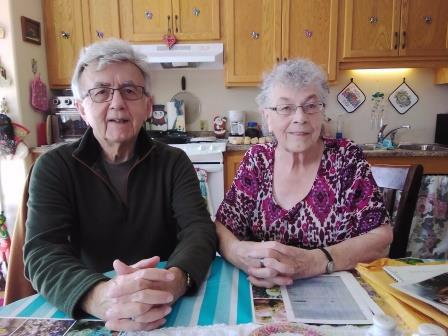
Pieter at the entrance to Vimy Ridge National Historic Site in France. We brought along a copy of the County Line Courier newspaper that publishes many of the stories about Island soldiers. (Photo credit: Daria Valkenburg)
June 14, 2023. After visiting the Vimy National Memorial in France and having researched several soldiers who fought during the Battle of Vimy Ridge, we have an ongoing interest in learning more about those who fought in that battle on Easter Monday, April 9, 1917.

Pieter with Connie Paynter. (Photo credit: Daria Valkenburg)
…Two brothers from Covehead enlisted …
Therefore, when Connie Paynter of Summerside contacted us about a 20 year old relative who was killed in action at Vimy, we wanted to meet her. “…My grandfather and my great-uncle, who lived in Covehead, both served in WWI. Only my grandfather, Lawrence Ivy Marshall, returned home…” she said.
Connie’s great-uncle, Merrill Augustus MARSHALL, was born on July 4, 1896 in Charlottetown, Prince Edward Island, the son of James Lawrence and Hattie Lillian (nee Carr) Marshall.
When he enlisted with the 55th Battalion on May 1, 1915 in Charlottetown, he noted that he had served in the 82nd Regiment militia for a year, with the rank of Sergeant. Before enlisting, he had worked on his father’s farm.

Merrill Augustus Marshall while serving with the 82nd Regiment, Canadian Militia. (Photo courtesy of Connie Birt Paynter)
While he was in the 82nd Regiment Militia, Merrill was sent to Valcartier, Quebec, where his brother Lawrence was also stationed. In an August 22, 1914 letter that Lawrence wrote to his mother from Valcartier, he noted that “…Merrill has the job of orderly so far. He will do alright if he keeps that job all the time…”
…Merrill was too young for active service …
However, as Merrill was underage for active service, he was soon on his way back home. In a September 9, 1914 letter from Merrill to his mother, written from 12 Battalion, 3 Brigade, Valcartier, Quebec: “…I will be home whenever we get the pay that is coming to us here. It will be 15 dollars. We got seven dollars and 40 cents that was coming to us from town. I am sending you 5 dollars this time. I won’t be here very much longer now. Our names are in for us to go home whenever we get our money given to us…”
…Merrill soon re-enlisted! …
A few months later, he re-enlisted and arrived at Camp Sussex, New Brunswick on May 10, 1915. After completing basic training he left Canada with the 55th Battalion on October 30 1915, aboard the RMS Corsican, which sailed from Montreal, Quebec. (See http://the-weatherings.co.uk/pccship0063.htm)
Merrill arrived at Devonport, England on November 9, 1915, and was sent to Bramshott Camp in Hants.
His brother Lawrence was also in England. In a November 29, 1915 letter to his mother, written from Bramshott Camp, Lephook Hants, 55th Battalion, No 10 Company, UK, Merrill assured her that “…I am well and having a good time… The drill isn’t half as hard as it was in Canada. We have good food and a good hut to stay in …. Don’t have to sleep in tents and suffer with the cold. Now we have a stove and lots of coal to burn so we are happy. I am getting a pass to Leicester to see Lawrence day after tomorrow….”
…Merrill trained to be a Signaller …
On April 8, 1916, Merrill was transferred from the 55th Battalion to the Canadian Signals Base with the 39th Reserve Battalion in West Sandling in the United Kingdom, where he trained to be a Signaller. He would have encountered fellow Islander, John ‘Lymon’ WOOD of North Tryon, who arrived there on April 16, 1916 for the same training as a Signaller.
Signallers were responsible for military communications, providing commanders with information on where troops were, what they were doing, and whether supplies were sufficient. Communication was done using message-carrying pigeons, flags, and human runners. Some messages could be sent using Morse code or signalling lamps. Signalling lamps were portable and aimed a focused beam of light at a receiving signaller. Light could be transmitted over long distances much faster and more safely than a runner exposed to enemy fire.
Merrill was transferred to the 6th Reserve Battalion in Shorncliffe on January 4, 1917. His brother Lawrence, who had been in the French trenches and was back in England, showed concern in a January 29, 1917 letter to his father, written from Canadian Convalescent Hospital, Staff Hut A1, Wood Cote Park, Epsom, Surrey, England: “…Had a letter from Merrill yesterday. He is in Shorncliffe and having a good time of it. I hope that it will only last the rest of the war and hope and pray that he never sees the trenches, because you have a pretty slim chance of getting back alive out there, and by the talk of things there is going to be harder fighting out there this spring than there has been. They are putting every man that’s fit out there this spring and try to make one big drive for the last time, but I don’t think that there is much use of doing it. Germany ain’t beat yet nor won’t be for a while…”
…Merrill was sent to France in advance of the Battle of Vimy Ridge …
Lawrence was right to be worried, as on February 7, 1917, Merrill was transferred to the 21st Battalion in East Sandling. The following day, he arrived at the Canadian Base Depot at Rouelles Camp in Le Havre, France. A few days later he joined his unit, and on February 15, 1917 he was on the front line, as a Signaller, with the 21st Battalion in Thelus, near Vimy Ridge.
In a February 11, 1917 letter to his father, written from Canadian Convalescent Hospital, Staff Hut A1, Wood Cote Park, Epsom, Surrey, England, Lawrence asked “…Have you heard from Merrill since he went to France? I have been expecting a letter from him the last week, but did not receive any. He will find quite a difference over there to what he had in England, but still he will get a good job as he is a signaller. He may never have to go into the trenches at all….”
Then, in an April 16, 1917 letter from Lawrence to his mother, written from Canadian Convalescent Hospital, Staff Hut A1, Wood Cote Park, Epsom, Surrey, England he wrote that “…I had a letter from Merrill. He was fine when he wrote. He said that it wasn’t too bad out there yet. I only hope that he will come through it all safe and sound….”
…Merrill lost his life during the Battle of Vimy Ridge …
Unfortunately, by the time Lawrence wrote his letter, Merrill was dead. He had lost his life on Easter Monday, April 9, 1917, during the Battle of Vimy Ridge, killed during the advance on the Ridge.
Merrill was buried near where he fell. His grave location was registered as being in ‘Thelus, near Neuville, St. Vaast, 4 ½ miles North North-East of Arras, France’.
… Merrill’s grave couldn’t be found …
However, years later, when what we know today as the Commonwealth War Graves Commission went to move the trench burials into cemeteries, his remains could not be located. Continuous artillery fire over the next year and a half remaining in the war likely destroyed his grave and many others.
This happened to fellow Islander George Albert CAMPBELL, who was killed during the Battle of Mount Sorrel in Belgium, and buried in Maple Copse Cemetery, east of Zillebeke. By the time the war ended, the cemetery had been destroyed and out of 256 named burials, only 26 could still be identified. (See https://onthewarmemorialtrail.com/2017/12/08/two-campbell-brothers-in-ww1/)
Once it was determined that Merrill’s remains could not be found, his name was commemorated on the Canadian National Vimy Memorial.
Merrill is also remembered on his parents’ grave at St. James United Presbyterian Cemetery in Covehead, Prince Edward Island.

Grave of Merrill Augustus Marshall’s parents at St. James United Presbyterian Cemetery in Covehead. (Photo source: http://www.findagrave.com)
Thank you to Connie Paynter for providing a photo of Merrill, and sharing the letters written by her great-uncle and grandfather.
If you have a story to tell, email Pieter at memorialtrail@gmail.com, comment on the blog, or tweet to @researchmemori1.
© Daria Valkenburg
… Previous postings about soldiers who fought during the Battle of Vimy Ridge and our visit to the Vimy National Memorial….
- Patrick Raymond ARSENAULT: https://onthewarmemorialtrail.com/2017/07/28/learning-about-the-two-names-on-the-vimy-memorial/
- Georg BRUCKER: https://onthewarmemorialtrail.com/2018/09/29/on-the-war-memorial-trail-luck-and-humanity-during-the-battle-of-vimy-ridge/
- Lloyd Clifford SHORTLIFF: https://onthewarmemorialtrail.com/2022/07/31/the-ww1-soldier-from-barton-whose-body-was-never-recovered/ and https://onthewarmemorialtrail.com/2023/01/07/on-the-war-memorial-trail-update-on-portrait-of-ww1-soldier-from-barton/
- John ‘Lymon’ WOOD https://onthewarmemorialtrail.com/2017/07/28/learning-about-the-two-names-on-the-vimy-memorial/ and https://onthewarmemorialtrail.com/2019/09/16/the-parallel-ww1-experiences-of-john-lymon-wood-clifford-almon-wells/ and https://onthewarmemorialtrail.com/2018/06/02/wwi-soldier-john-lyman-woods-connection-with-acadia-university/
- https://onthewarmemorialtrail.com/2017/09/19/visiting-the-canadian-national-vimy-memorial/
- https://onthewarmemorialtrail.com/2017/09/14/visiting-the-tunnels-at-vimy-ridge/
- https://onthewarmemorialtrail.com/2017/09/12/a-visit-to-vimy-ridge/
…Want to follow our research?…

If you are reading this posting, but aren’t following the blog, you are welcome to do so. Our blog address: https://onthewarmemorialtrail.com/.
 4 countries, 6 weeks, 7,000 km – an unforgettable war memorial journey in Europe…. Daria’s book ‘No Soldier Buried Overseas Should Ever Be Forgotten‘ is available in print and e-book formats. Net proceeds of book sales help support research costs and the cost of maintaining this blog. For more information see https://nosoldierforgotten.com/
4 countries, 6 weeks, 7,000 km – an unforgettable war memorial journey in Europe…. Daria’s book ‘No Soldier Buried Overseas Should Ever Be Forgotten‘ is available in print and e-book formats. Net proceeds of book sales help support research costs and the cost of maintaining this blog. For more information see https://nosoldierforgotten.com/
You are also invited to subscribe to our YouTube Channel: On The War Memorial Trail With Pieter Valkenburg: https://www.youtube.com/channel/UCJ591TyjSheOR-Cb_Gs_5Kw.
Never miss a posting! Subscribe below to have each new story from the war memorial trail delivered to your inbox.